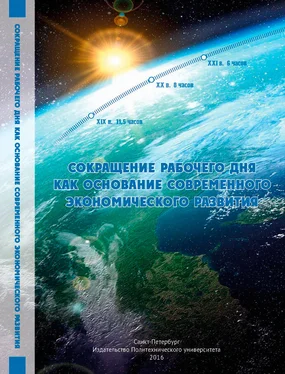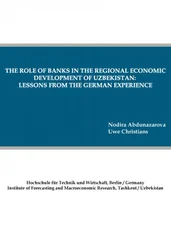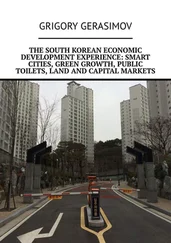Such tempos can exceed possible ones at universal participation in production if an increase in employment in production, outstripping growth of population, takes place. Obviously, superiority in tempos of working time reduction does not abolish its longer duration, as compared to the situation of universal participation in production. This factor of acceleration will work until the number of people occupied in production does not come up with the number of able-bodied people.
Universal participation of able-bodied people in social production supposes absence of social groups occupied in the nonproduction sphere only. Nonproduction activities, as well as production activities, must be distributed between able-bodied people. It is reasonable to study these prospects of economic development too.
Average Annual Working Time per One Employee in the Nonproduction Sphere at the Present Level of Economic Development and in Conditions of Universal Participation in Production
To calculate average annual working time per one employee in the nonproduction sphere let us use the method similar to the method we used when analyzing similar indices in the production sphere, comparing general labour expenditures to employment (table 24).
In all the examined countries both the number of people occupied in the nonproduction sphere and general labour expenditures in it increased. At that, in most of the countries growth of employment outstripped growth of labour expenditures (except for the USA and Sweden) what lead to decreasing in working time duration per one employee. Accordingly, the tendency to working time reduction is seen in this sphere too what creates prerequisites for a harmonious combination of different kinds of nonproduction activities by employees occupied in them.
Table 24
The Value and Dynamics of Average Annual Working Time per One Employee in the Services Sphere in Present Conditions

Let us consider the situation that would take place at universal participation of able-bodied people in rendering services.
Table 25
The Value and Dynamics of Average Annual Working Time Duration per One Employee in the Nonproduction Sphere at Universal Participation of Able-Bodied People in Rendering Services
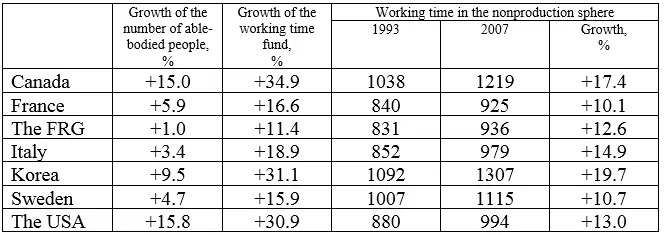
As it follows from the data, at universal participation of able-bodied people in rendering services duration of time for their rendering per one employee would grow in all the countries, while in present conditions it reduced in most of the countries. The point is that in the second case the effect of growth of the working time fund was surpassed by outstripping growth of employment. At universal participation in rendering services the factor of redistribution of able-bodied people between the main spheres of the economy works no longer, the number of employees combining production and nonproduction activities is determined only by the dynamics of population. Obviously, increasing in this number was seriously behind the growth of volumes of rendered services.
Increasing in working time duration in the nonproduction sphere at its reduction in production means that employees are more and more occupied in those kinds of activities that assist in their free development. In this respect it would be unreasonable to connect economic development to reduction of nonproduction activities time. It is quite another matter that total time of labour in satisfaction of social needs, including labour in production and the services sphere, must not go beyond the scope determined by the need for leisure. That is why it is necessary to take into consideration the value and dynamics of general working time duration.
Average Annual Working Time per One Employee in Social Production and the Nonproduction Sphere at the Present Level of Economic Development and in Conditions of Universal Participation in Production
At existing social economic fixation of big social groups in economically heterogeneous kinds of labour the value and changing in working time duration in the production sphere, on one hand, and in the services sphere, on the other hand, affect different groups of employees. When labour in different spheres is fulfilled by the same employees, the dynamics of working time in each of these spheres influences the social economic state of all able-bodied people.
For the comparative analysis of the value and dynamics of general working time duration, first of all, it is necessary to fix certain indices for employees in conditions of prospects of labour combination in production and nonproduction activities (table 26).
So, if each able-bodied person would fulfil production activities and labour in rendering services in equal proportions, then duration of the latter per one employee would significantly exceed working time spent on production by everyone. It has been expected from the results of the analysis of the general working time ratio in production, on one hand, and the nonproduction sphere, on the other hand.
Table 26
Labour Duration in Social Production and in the Nonproduction Sphere per One Able-Bodied Person in Conditions of Combination of these Kinds of Activities by Everyone
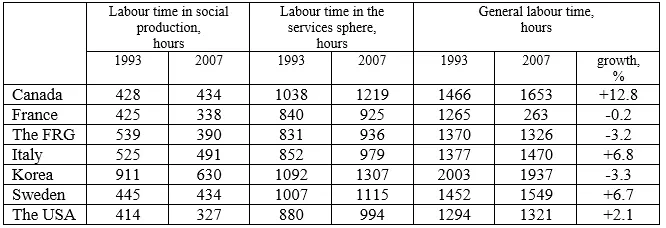
In most of the countries, except for Canada, average duration of production activities of employees would reduce. In all the countries decreasing in the part of production activities expenditures in general labour activities duration of employees and increasing in the part of nonproduction activities would take place. Taking into account that conditions and contents of labour in the nonproduction sphere are more favorable than in production, in general, this changing in the labour activities structure would assist in development of employees.
It is significant that in several countries (France, the FRG, Korea) reduction of labour activities duration of employees in satisfaction of social needs would happen what should increase time of their leisure. In the rest of the countries decreasing in nonworking time of able-bodied people would take place. Certainly, a 15 year period is not long enough for identification of a dominating tendency of changing in the ratio between duration of labour and leisure.
It is reasonable to compare duration and the dynamics of working time at combination of different kinds of labour by all employees to similar indices for people occupied in the basic spheres of the economy (table 27).
It is notable that working time of industrial employees is longer, as a rule, than working time of nonproduction employees (Korea is an exception). At this differentiation of employees it gives the basis for viewing working time duration in production as the upper limit of the average working time value.
If all able-bodied people would combine production activities and rendering services, then general duration of their working time would be less than general working time duration of present employees occupied in different spheres of the economy. It is viewed that these prospects are conditioned on the supposition of absence of unemployment and on equal distribution of labour between employees.
Table 27
Working Time Duration of Employees of the Production, Nonproduction Spheres, and Combining Production Activities and Rendering Services (Calculated According to the Data of Labour Expenditures and Employment in 1993 and 2007)
Читать дальше
